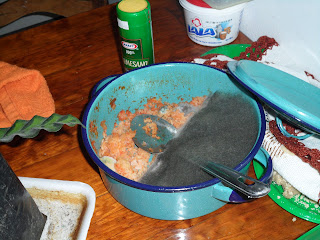 |
 |
Lisette is a smart woman and knew what she was doing when she filled the itinerary. By the time we had a walking tour through the city of Oaxaca, ate dinner and settled into the hotel, we were too tired to do much except watch a movie. A great thing about Mexico is that although Netflix doesn't work and Blockbusters are less than common, pirated DVD shops are literally on every other corner. Disaster struck our moviewatch event when I was allowed to pick the movie. Babel is apparently not the light, uplifting film that the group had in mind. Whoops.
We dragged ourselves out of bed at the crack of dawn (ok that's an exaggeration), nommed some nomz and piled back into the camioneta. Our first stop was probably my favorite of the day. The Tule Tree supposedly has the largest tree trunk in the world, by circumference. Secretly, I think that it is multiple trees that grew together, but we'll leave that out for the sake of impressive statistics. We were all thinking, "Ok this tree is impressive, but at the end of the day, it's just a tree". Then Lisette hired a tourguide. This kid could not have been more than 8 years old, but he had his act DOWN. He led us around the Tule Tree, pointing out animal shapes in the trunk with his little mirror. While the subject matter itself was only vaguely captivating, this kid's inflection and phrases were priceless. But you don't have to take my word for it…
This is a fakeout. The video didn't load. I guess to sum it up, I'll tell you that his go-to line was ¿ya lo vieron? which means "Did you see it yet?"
 |
The next stop on Lisette's Worldwind Mexican Adventure was a "lemonade" factory. The Mexican countryside is covered in agave plants of every shape and size. The smaller plants are commonly known as aloe vera, the HUGE ones are called maguey, and some of the middle ones are used to make fermented & distilled alcohol. The most commonly known product of agave plants is tequila, but this is actually a type of mezcal, a specialty in Oaxaca. So I lied. We didn't stop at a lemonade factory (lemons aren't even Mexican, silly!); we stopped at a mezcal factory. Don't worry, it was a very educational experience, featuring a tour of the entire operation and samples hot off the distiller. Viva. Mexico. Needless to say, everyone was in a great mood by the time we headed to a buffet lunch. Even after 4 months in Mexico, I have still not managed to adjust to the meal schedule here. An 8AM breakfast just doesn't hold me over until lunch at 2 or 3PM and I am always starving once a mealtime comes around.
We were soon hustled out of the restaurant and onward to the next activity. Mitla is a unique archeological site because unlike the large majority of sites in Mexico, it is not a pyramid. Mitla is home to a living residence/palace. The thing that struck me most about this house was the stairs up to the front door. The ancient inhabitants of Mitla must have been very strangely proportioned, with small feet (to fit on the narrow stairs), long shins (to make the steep stairs reasonable) and killer thighs. This family definitely didn't get many trick-or-treaters knocking at their front door. After learning about the site with Cyclops, we were able to wander around the little town and I made an unexpected friend. A little girl, Briana, invited Erica and I into her parents' shop with the greeting, "Hi! I want y'all to be my friends!" Briana didn't take "Sorry, we have to go soon" as an answer and continued on with introductions. By the time we were able to excuse ourselves, we had met uncles, cousins, and parents, with the promise of more introductions to come. This little episode made me realize just how much I'm going to miss the open, welcoming attitude in Mexico. This is related to another realization that I had recently: my Embarrassment Threshold is infinitely higher than it used to be. Previously, for example, I didn't like asking people questions if I didn't know them, but now I'm fine asking just about any random person for directions or information on why there are excessive fireworks on any given day or why there are frogs everywhere or how to say saltshaker in Spanish. This is partially due to general personal growth and partially due to the warm, helpful response that similar questions usually receive.
But back to the plot. Sunday was another busy day in Oaxaca, full of museum visits, mass, souvenir shopping, a barro negro or black pottery workshop "tour" (the tour plan was foiled when the potter was busy filming a documentary on barro negro), and of course, food. En route home on the bus, I realized that I had yet to study for my 9AM Monday final, just in time for the sun to drop out of sight behind the mountains. The Me of 6-months ago would have spent the rest of the busride stressing over said final. The Mexico Adventure Me thought "no te preocupes", took a nap and half-heartedly studied with hot chocolate once we got back to UDLAP. And you know what, it was fine.







